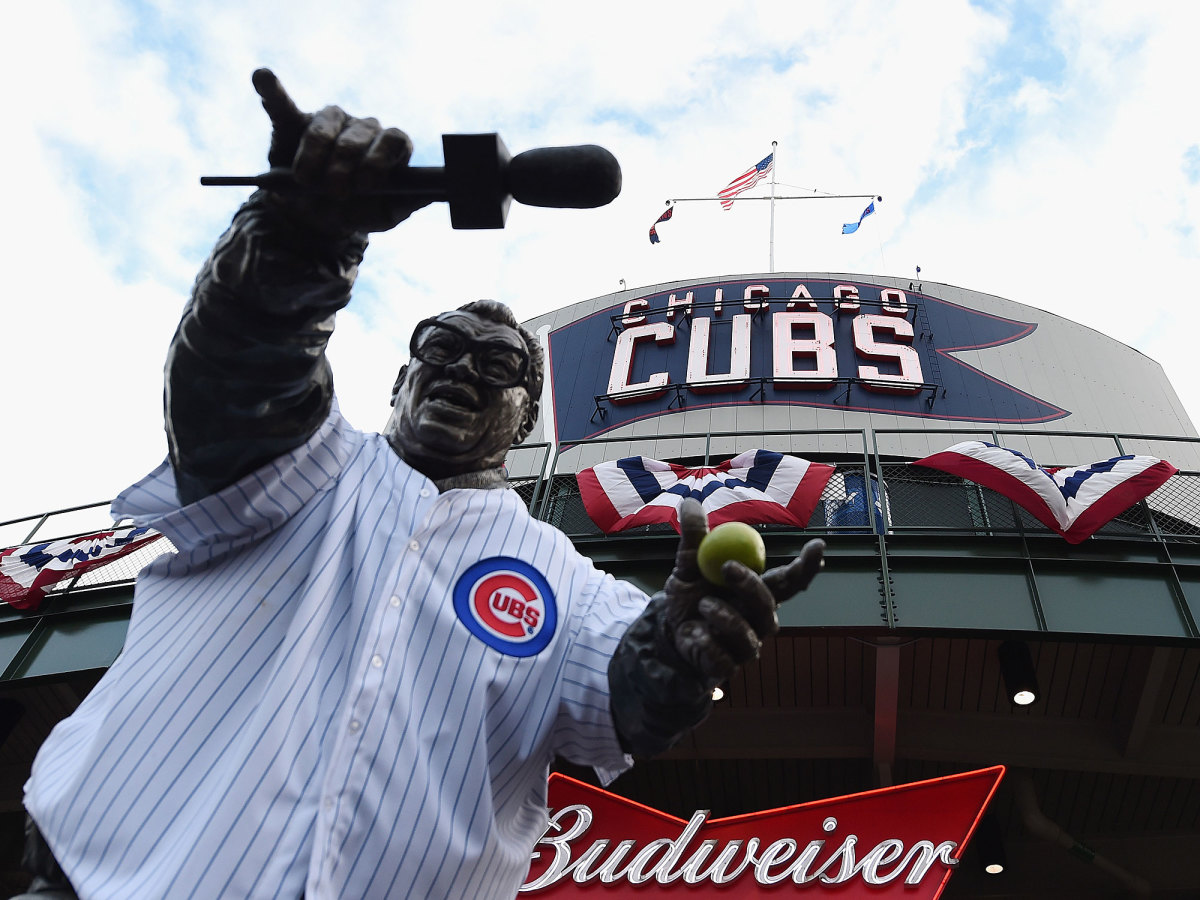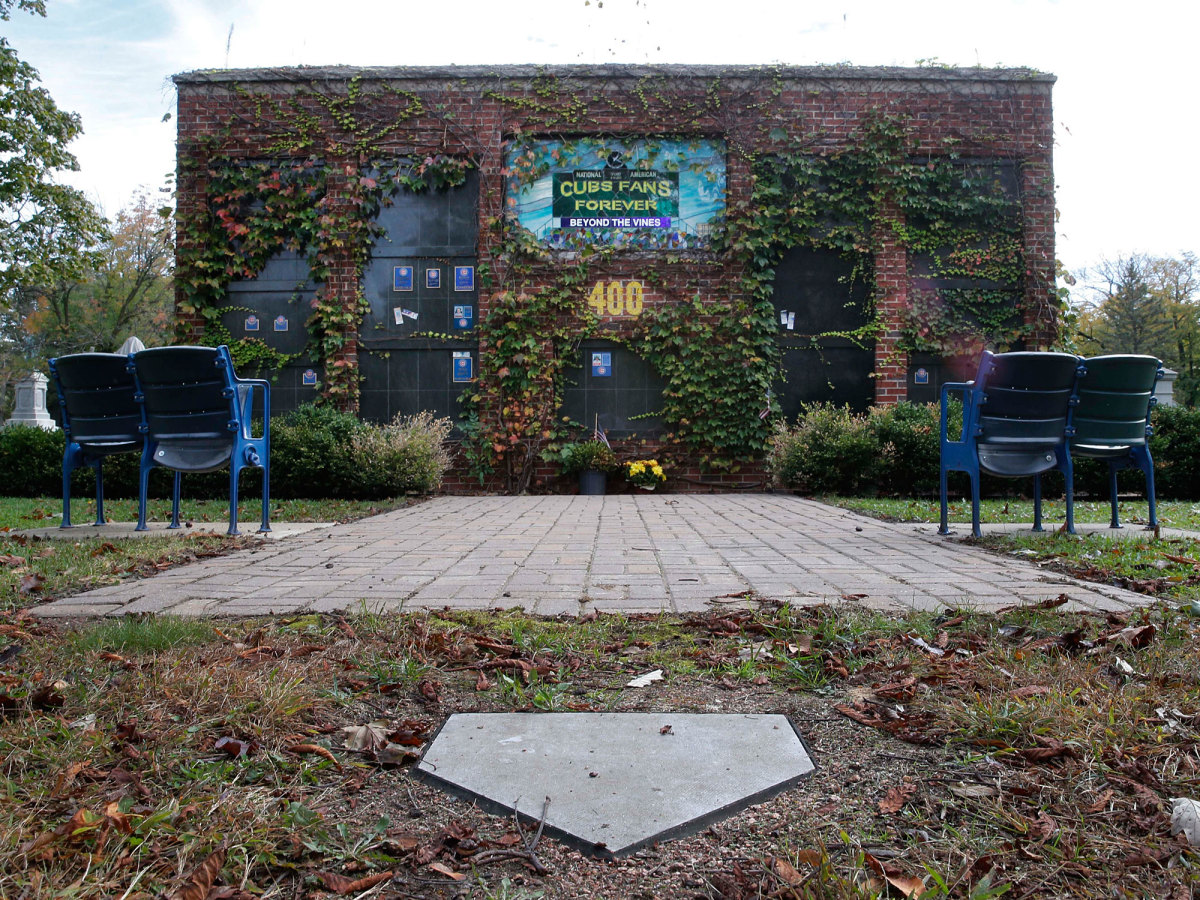Scenes from Wrigleyville: Quiet days and long nights near the ballpark

CHICAGO—They started trickling out of the bars when the game seemed in hand, when they should have known better. They whooped and ran and brought the celebration back to Wrigleyville an hour before their team bathed in champagne 350 miles away. There were six outs to go, and the Cubs had a three-run lead in Game 7 of the World Series, and the ballpark was right there, just glowing and inviting them, this lit-up behemoth down the street.
You couldn’t fault these long-suffering fans, and even when the Indians' Rajai Davis hit a game-tying home run and the ensuing rain delay quieted their songs and pushed them back inside, the neighborhood still pulsed. The shouts were queued up, the fireworks ready, so that the second that final pitch beamed through the airwaves, Cubs fans had already let loose.
Wrigleyville was something else altogether on Wednesday night—a sea of humanity that pushed up against the police barricades that contained it. It swayed in song and it swayed precariously, fans gripping strangers to stay upright as the wave pushed toward Clark and Addison Streets from the south. On the backside of the ballpark, things were quieter. Fans stood in awe, and there was space to shoot off a firework or smoke a seventh cigar. Still, there was no place to go, nothing to do but sing or scream or wait—but for what anymore? The Cubs had finally won the World Series.
• Scenes from Wrigleyville: Cubs fans celebrate title | Police scanner
It was the end of a month-long party. It was relief. It was spontaneous verses of “Take Me Out To the Ballgame” and “Go Cubs Go,” sung surprisingly in key for a mass that nearly drank Wrigleyville dry. It was high mass at baseball’s altar, and if you stood in Wrigleyville as Thursday morning dawned and didn’t want to convert, well, you might be missing a heart.
On Monday morning, they came from the train and they came on foot. They came with their dogs and their babies who have never known a world in which the Cubs are bad, with toddlers in Halloween costumes and aunts who hadn’t dared to brave the weekend crowd.
By noon, the streets surrounding Wrigley Field had been wiped clean of the weekend’s debauchery, of the three games that saw the Cubs fly off to Cleveland facing a 3–2 deficit with no margin for error. The blue wooden police barricades had returned to wherever such things belong, and plastic beer cups had been removed from puddles of who-knows-what, and those same puddles of who-knows-what had nearly disappeared. Construction had begun again on the demolished lot south of Addison Street, with cement trucks and cranes already at work to bring Wrigleyville into 2017. Outside the marquee at Clark and Addison, a lone security guard patrolled the easiest job he had all week: watching elated fans ask other elated fans to please snap a photo, and thank you.
Teri Lydigsen, her daughter, Rikki Sargeant, and her sister, Sandy Cece, had their trip from Florida scheduled for three months. They’d planned to spend the weekend with friends and family in Chicago—where Lydigsen had spent time as a child and Cece lived until a year ago—and attend Monday night’s Bears-Vikings game. But as the baseball season progressed, the three women realized: They’d be in Chicago if—a big if, given the team's history—the Cubs made it to the World Series.
Reign Men: The storm, the speech and the inside story of the Cubs' Game 7 triumph
None of the three women were able to attend any of last weekend’s games at Wrigley Field, but being in the area was enough of a happy coincidence for the family. Lydigsen ventured out into the Wrigleyville fray on Saturday night to see the sights, but for Cece and Sargeant, the Monday trip was the closest they got to Wrigley during the Series. They’re all sports fans thanks to Lydigsen and Cece’s father, Marion Lydigsen, whom the women took to his last Cubs game three seasons ago. (He passed away in 2014.) Even since then, they remarked, the neighborhood had changed, and Cece recalled her time living northeast of the ballpark with a view of the scoreboard—when that scoreboard was the outfield’s only attraction.
Behind the three women, Wrigley’s marquee showed few signs of the series. An Indians flag still flew where opponents’ colors had hung all season, but the electronic ticker advertised for Express—Cubs third baseman Kris Bryant is a brand ambassador—and ATI Physical Therapy rather than a score or game time. Monday was a day of relative peace, and Cody Smith and Billie Lin took advantage of the open streets and perfect fall weather to walk their dogs, Bailey and Rex. They did this often on off days and in the winter; the two live within blocks of the ballpark, and all weekend, their stomping ground was flooded. Only on Monday could they pay their respects to Wrigley, which they did by placing a tiny plastic Cubs hat—the kind that most often come full of soft-serve ice cream—on Bailey’s head for a photo.
• Get SI's Cubs 2016 World Series championship package

Halloween weekend in Wrigleyville is a madhouse without the Cubs in the World Series. The ballpark is perhaps the most integrated of any into a neighborhood where actual human beings go about their daily lives; there are families in beautiful greystones, recent college graduates in crummy duplexes and everyone in-between. In the week before the World Series returned to Wrigleyville for the first time since 1945, news of bar cover prices trickled out. At HVAC, a block south of the ballpark, a six-person table cost $1,000; food and drink packages were $250 per person. Tables at Deuce’s, Casey Moran’s and John Barleycorn, three more popular Clark Street bars, went for $500. With ticket prices in the thousands of dollars, it might have seemed like the average Cubs fan would be priced out of the neighborhood, but to think that would be to underestimate Chicago.
All weekend, 1,000 cops lined the streets surrounding Wrigley, which were mobbed with fans. (With 17 homicides, the weekend was also Chicago’s deadliest in 2016, although none occurred within more than two miles of the ballpark. The Chicago Police Department said the surge of officers to the North Side did not deplete any other area’s forces.) Each night, fans who had either arrived too late to get into a bar or were unwilling to pony up a week’s salary for a spot simply took to the streets. Each bar boasted a crowd gathered around its windows watching its TV—as did many apartments. For Game 4 on Saturday, the swell around 1032 W. Waveland, beyond the outfield wall, was especially large. There, fans could multitask and hope to catch a home run while also peering through a stranger’s living room window at a huge flat-screen TV. In another ground-floor apartment of the building, it was impossible to see any screens through the crowd assembled inside. One barefoot woman sat in the windowsill on a 65-degree night, a scorecard in her lap.
• Cubs fans on what title means to them | Wrigley wall dedicated to late family members
On the south side of Wrigley, a group of five religious protesters had set up shop by the second inning with posters and a megaphone. The one woman among the bunch did the talking, explaining to anyone who would listen the difference between going to jail and going to hell. The crowd inside the ballpark hushed as the Cubs ceded their one-run first-inning lead, and the megaphone crowed on. It took no time for a crowd of costumed Cubs fans—this group in furry cat suits—to assemble and peacefully protest the protest. As the woman compared the neighborhood to Sodom and Gomorrah, they clapped, held hands and yelled, “Go Cubs!” A police officer, who asked to remain anonymous, said she didn't anticipate a problem with the group. “There aren’t fights up here,” she said. “Everyone’s too happy.”
Grandparents who waited decades for this had the best reactions to the Cubs’ win
But by Sunday, that happiness was tempered with dread: The Cubs had dropped their first two home games of their first World Series in 71 years. Wrigley and the streets were full, but the buzz was apprehensive. Fans didn’t stray far from the windows they’d staked out, but when Aroldis Chapman struck out Jose Ramirez to complete an eight-out save and a 3–2 win, the place erupted. The entire ballpark—the entire neighborhood, really—broke out into “Go Cubs Go” and “Sweet Home Chicago,” and 15 minutes after that final pitch, a grown man in a Winnie-the-Pooh costume clutched a beer and a gold purse and danced down his aisle in section 406.
Outside Wrigley, fans collided in nearly every direction. Some were bound for the train, others to nearby bars, others to the statue of Harry Caray that was covered in green apples as a tribute to his now-famous quote. At the same time, the neighborhood teemed with fans pushing toward Wrigley, to get as close as they could to her one last time, maybe, after one last magical home win, hoping for the best in Cleveland. Fans scribbled with chalk on Wrigley’s east wall; the police stationed there agreed they had no idea where the original chalk had come from. But the fans had been coming all night, handing off pieces to the next in line to scrawl a name to commemorate being here—or in tribute to someone who couldn’t, who’d waited a lifetime for a night like this one and never gotten to see it.
Just south of the ballpark, a group of 20-somethings gathered to debate their next move. One of the men spotted Millie, a brown goat who’d been making the rounds all weekend with her owner, Joe Roetter. The man broke from the group to follow Millie’s entourage and pet her. He returned to his friends, who squealed at what he’s done. “Ethan touched the goat!” one woman shrieked. “Is that bad?” another woman asked. “No,” the man replied. “It’s a lucky goat!”

On Monday, half a mile north of Wrigley, a field trip of elementary schoolchildren descended upon Graceland Cemetery. It was Halloween, and the kids were supposed to write about someone buried on the grounds. They were more interested in playing tag. In Wunder’s Cemetery, the more modest graveyard across Irving Park Road, several headstones were draped in W flags and rally towels. A Virgin Mary statue wore a Cubs scarf. But at Graceland, there was little evidence of what had transpired down the street this summer. The cemetery is also an arboretum; its trees tower and its gravesites are imposing—obelisks, raised tombs and in one case a building that looks like a tiny Parthenon by the side of a pond.
Across the water lies the grave of noted architect Mies Van Der Rohe, who passed away in 1969 in Chicago. Van Der Rohe designed many of the modernist skyscrapers in downtown Chicago in the mid-20th century, and just a few graves south of his lies the final resting place of another man who in his own way helped build the city: Ernie Banks.
Mr. Cub was laid to rest at Graceland in 2015, although he was without a gravestone until this fall, when an anonymous donor purchased one. It’s an unimposing, diamond-shaped granite stone, with Banks’s No. 14 inscribed in the middle. A dozen roses are propped against it, and in front lie a bunch of yellow carnations and two Cubs rally towels, one from the postseason. Ellen Shapley only noticed the grave, she said, when a group of men walked up to visit it while she was taking in the cemetery’s architecture. She works as a volunteer giving architectural tours in Portland, and as a lifelong Cubs fan, she said she couldn’t have been anywhere else last weekend but Chicago. She boarded a flight with no tickets, only an idea.
As an 18-year-old college student, the Iowa native made the trip into the city with a group of friends for a late-season game in 1969. The Cubs were set to snap their 24-year-long postseason drought (until a late-season skid doomed them), and tickets to games were too expensive. But she and her friends wanted to see Wrigley regardless, and as they walked through the neighborhood one night, a well-dressed man handed them a stack of tickets. He wouldn’t take their money and didn’t give them a name, and the teenagers thought for sure they were counterfeit. Even so, they walked to the gates of Wrigley, handed over the tickets—and they worked. Once inside, they had seats about 10 rows up from first base and Mr. Cub himself.
This weekend, Shapley thought she might stumble upon the same luck she found 47 years ago. But there was no strange man, and there were no strange tickets, although the people on the streets of Wrigleyville to whom she told her story were charmed. On Sunday night, as the Cubs clung to their lead and the clock pushed past 10 p.m., she was exhausted from standing so long on the streets. Hoping for the best, she set off toward a girlfriend’s home about a mile from the stadium. Once far enough away from the ballpark that the crowd had thinned, she stepped into a neighborhood bar to catch the ninth inning. There, she met an older man who told her his Cubs story, and she told him hers, and their team stayed alive, and someday they’ll both tell this new story, of the night the World Series played on, the night they knew they had a chance.
